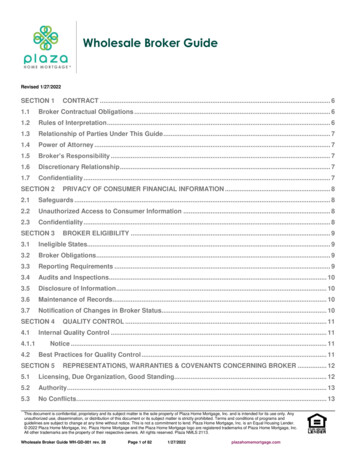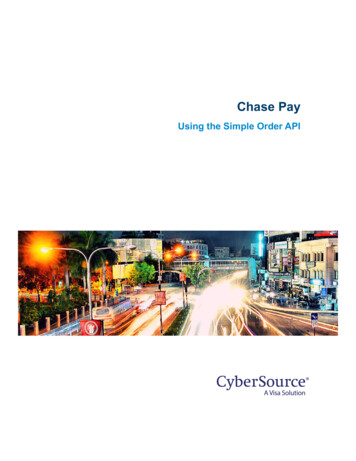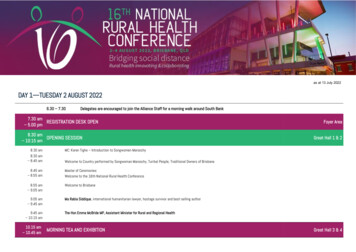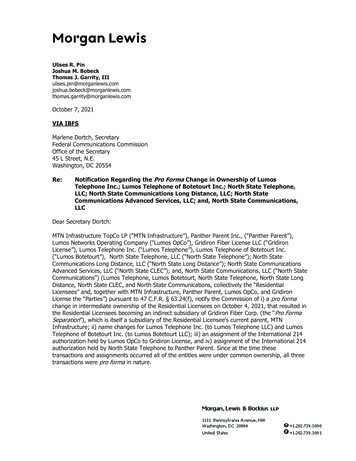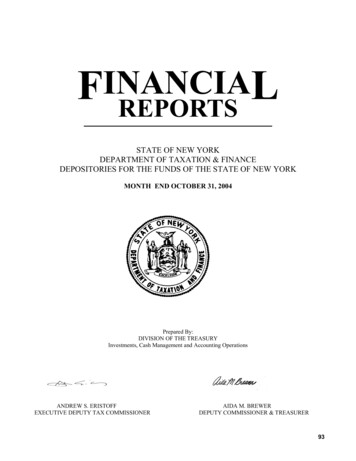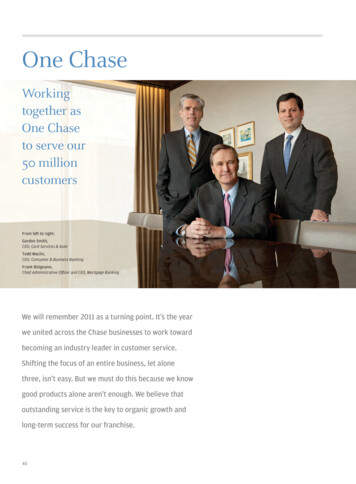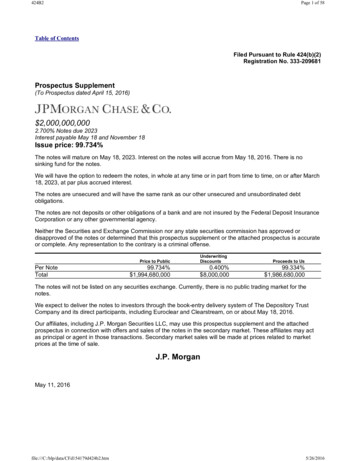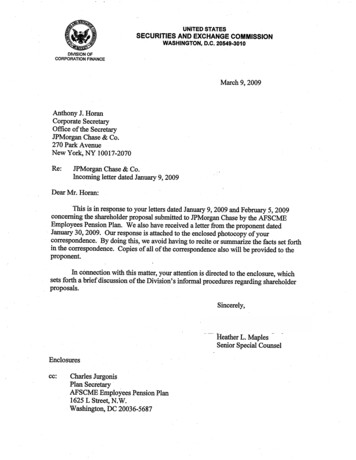
Transcription
Landmarks Preservation CommissionFebruary 10, 2009, Designation List 410,LP-2294ONE CHASE MANHATTAN PLAZA (aka 16-48 Liberty Street, 26-40 Nassau Street, 28-44 PineStreet, 55-77 William Street). Built 1957-64; Skidmore, Owings & Merrill, architect, Gordon Bunshaft,partner in charge of design, Jacques E. Guiton, lead designer.Landmark Site: Borough of Manhattan Tax Map Block 44, Lot 1.On June 24, 2008, the Landmarks Preservation Commission held a hearing on the proposed designation ofOne Chase Manhattan Plaza and the proposed designation of the related Landmark site (Item No. 12). The hearinghad been duly advertised in accordance with provision of law. Seven people testified in support of designation,including the building’s owner J. P. Morgan Chase, as well as representatives of City Council member Alan J.Gerson, United States Representative Jerrold Nadler, DoCoMoMo New York Tri-State, the Historic DistrictsCouncil, the Modern Architecture Working Group, and the Municipal Art Society.SummaryFaced with shimmering panels of natural color andblack-enameled aluminum, H-shaped mullions and glass, OneChase Manhattan Plaza is among the largest and mostimportant 20th century skyscrapers in New York City.1 Theproject was designed by Skidmore, Owings & Merrill(hereafter SOM), with J. Walter Severinghaus as partner incharge, Gordon Bunshaft overseeing the development of thedesign, and Jacques E. Guiton as lead designer. It was one ofthe leading architectural firms working in the InternationalStyle and had been responsible for such pioneering modernworks as Lever House (1950-52) and the Fifth Avenue branchof the Manufacturers Hanover Trust Company (1953-54).Chase merged with the Bank of the Manhattan Company in1955 and the new headquarters was planned to consolidate8,700 employees under a single roof. David Rockefeller playeda leading role in the project; as executive vice president heconvinced Chase to remain downtown and hire SOM, resultingin an 813-foot-tall slab-like tower that dramatically altered theskyline and character of the financial district. At that time, fewbuildings had been constructed downtown since the early1930s and One Chase Manhattan Plaza signaled a new start for this historic area. Not only did it stand outsharply from its older masonry neighbors, but the planning of the site, incorporating an irregularly shaped2½ acre plaza, established a welcome break from the narrow, twisting streets that characterize much ofthe neighborhood. Construction started in 1957 and the tower was mostly complete by 1961. The southplaza and basement levels were dedicated in 1964, incorporating a “Sunken Garden” by the sculptorIsamu Noguchi. Resting 16 feet below the plaza, this serene work of art is visible from above and throughcurved glass windows that separate it from the bank’s main branch located on the concourse level.Architecture critic Ada Louise Huxtable praised the design in the New York Times: “These are ambitiousstructures of character and quality, surrounded by the most expensive urban luxury money can buy –space. In a remarkable duality of purpose, reconcilable only in this commercial age, they aspire to thedual role of company trademark and work of art.” The structure was also described in ArchitecturalForum as “a milestone, perhaps even an end point in the development of the American skyscraper.”2 Ashoped, One Chase Manhattan Plaza did lay significant groundwork for a downtown renaissance in the1960s, leading to construction of a succession of corporate towers immediately west, from the MarineMidland Bank Building in 1967, to the World Financial Center complex in 1985-88.
DESCRIPTION AND ANALYSISFew buildings have had as significant an impact on the character of lower Manhattan as OneChase Manhattan Plaza. Completed in 1964, it was one of the financial district’s first buildings to boldlyreflect the aesthetic and planning strategies of 20th century European modernism, often called theInternational Style. Rising at the north end of a 2½ acre plaza, the 813-foot-tall tower symbolized thebank’s long-standing commitment to the area, leading to the eventual creation of the World Trade Center(1962-73) and the World Financial Center (mid-1980s).Chase Manhattan Bank and David RockefellerChase National Bank merged with the Bank of the Manhattan Company in April 1955, making itthe second largest financial institution in the nation, with 8 billion in assets and 87 domestic branches.Both shared strong ties to lower Manhattan and had been founded a short distance from the site. The Bankof Manhattan, for instance, first served depositors in 1799 where 40 Wall Street stands today and Chasewas founded at 104 Broadway, near Cedar Street, by banker and publisher John Thompson in 1877.Named for Salmon P. Chase, secretary of the U. S. Treasury under President Abraham Lincoln, it grew tobecome the largest bank in the world by 1930. In the late 1940s, however, National City Bank and theBank of America National Trust and Savings (later Citibank and Bank of America) surpassed Chase andthe New York Times commented that following such success it was not easy for the bank “to take a backseat, much less than stay in it.”3Six months following the merger, in November 1955, Chase Manhattan Bank announced plans toerect a new headquarters. John J. McCloy was the bank’s president (1953-55), and later, chairman (195660). Trained as a lawyer, he had been assistant secretary of war under President Franklin DelanoRoosevelt and headed the World Bank from 1947 to 1949. To supervise the project, in January 1955 hepromoted David Rockefeller (b. 1915) to executive vice president for planning and development.Rockefeller had first joined the bank as a manager in 1946. His parents, John D. Rockefeller, Jr. andAbby Aldrich Rockefeller, were major philanthropists, having played leading roles in the creation ofmany familiar New York City structures, such as Riverside Church, Rockefeller Center, and the Museumof Modern Art. David Rockefeller remained associated with Chase for most of his career, becoming itspresident in 1960, and chairman of the board and chief executive officer in 1969. He received a goldmedal from the Downtown Association in 1956 for his role in planning the new headquarters and alsohelped found the Downtown-Lower Manhattan Association in 1958.4 Under his leadership, thisorganization helped plan the South Street Seaport, the World Trade Center, and Battery Park City.According to Rockefeller, it was he who convinced McCloy to hire a “qualified outside firm,”Ebasco Services Incorporated, to evaluate the bank’s real estate needs.5 This consultant prepared severalsurveys and reports in 1954 and 1955, concluding that a long-term solution was needed – one that wouldconsolidate various banking operations in a single structure. Chase owned seven buildings in the vicinityand Ebasco determined most of these facilities to be substandard. Though the 1954 report did not take aposition on where a new headquarters should be erected, it noted the operational advantages of remainingdowntown, as well as the current value of the bank’s property. A subsequent report evaluated two sites:the “Broad Street block” (bounded by Broad, Wall and William Streets and Exchange Place), as well asthe block that Chase would ultimately purchase.Rockefeller worked closely with William Zeckendorf (1905-1976), a long-time family advisor, tofind an ideal location. A prominent real estate developer and broker, he assembled the site of the UnitedNations and sold it to the United Nations Organizing Committee which received an 8.5 million gift fromJohn D. Rockefeller for this purchase. He also built such ambitious commercial and residential complexesas Roosevelt Field on Long Island, Mile High Center in Denver, and Kips Bay Plaza in Manhattan.Though Chase contemplated the purchase of various sites, both downtown and elsewhere, it was thepending sale of the block directly north of the bank’s Pine Street headquarters, bounded by Cedar,Nassau, Liberty, and William Streets, that helped finalize their decision. The 60,000 square foot site hadbeen occupied by a Romanesque Revival style structure (Charles W. Clinton, begun 1882) and six otherbuildings erected by the Mutual Life Insurance Company of New York. Vacant since 1950 when the firm2
moved to Broadway and 55th Street, the block was currently owned by the Guaranty Trust Company ofNew York.6 At a hastily-convened meeting with Chase executives at the bank’s headquarters in February1955, Zeckendorf recounted saying:There is only one logical musical chair open and available to you – I pointed out thewindow . . . The Mutual Life site is under negotiation for sale and you have no time. Youmust bid for it today.7As one of the largest sites available in the area, the bank acted without delay, paying 4.67 million. Chasecontinued to claim there were “no definite plans for a new head office” but decisive action had been takenand a contract was signed in May 1955 to begin demolition of the entire north block.8Skidmore, Owings & MerrillSOM was selected to design Chase Manhattan Plaza in spring 1955. Founded in Chicago in 1936,this architectural firm was responsible for many prominent corporate structures in the United States,including a recently-completed branch of the Manufacturers Hanover Trust Company (1953-54, adesignated New York City Landmark) located at the southwest corner of Fifth Avenue and 43rd Street.This aluminum-and-glass walled structure drew strong praise from both architectural critics anddepositors, which reportedly tripled in number during the first year of operation. Rockefeller said it washis close friend architect Wallace K. Harrison who “unhesitatingly recommended” SOM.9 Thisrecollection contrasts sharply with that of Nathaniel A. Owings, who later claimed the firm pursued thejob independently and without direct invitation. Architectural Forum reported:Hearing rumors, SOM partners swung into action, called Senior Partner Nat Owings infrom San Francisco to ask for a meeting with David Rockefeller.10According to Chase Manhattan Magazine, the complex was planned by 4 of the 13 general partners atSOM: Gordon Bunshaft (1909-1990), Edward Mathews (c. 1903-1980), Owings (1903-84), and J. WalterSeveringhaus (1905-87). Each member of the firm had different responsibilities and though Owings wasone of the firm’s founding members, it was Severinghaus who headed the project, with Bunshaft aspartner in charge of design. Bunshaft, who supervised many projects simultaneously, assigned it toJacques E. Guiton (b. 1913-?), who prepared the preliminary scheme in collaboration with Roy O. Allen(d. 1992) during the summer of 1955. Guiton recalled that he was:. . . dumbfounded when, in June of 1955, one of the partners told me I was going to bethe project designer for a new job: the headquarters of Chase Manhattan Bank.11Trained in Paris at the Ecole des Beaux Arts, Guiton immigrated to the United States in 1948. Brieflyemployed by the New York architects Leonard Schulze and Walker & Poor, he developed a stronginterest in work by French architect Le Corbusier and when he found himself jobless in 1950 decided toapproach Bunshaft. Initially, he worked as a draftsman but after designing Chase Manhattan Plaza heworked on the master plan for the Tunis airport in Tunisia, an unbuilt printing plant for the ClevelandPlain Dealer, as well as buildings for various American universities. Following his retirement in 1981, heauthored two books: The Ideas of Le Corbusier on Architecture and Planning (1981) and A Life in ThreeLands: Memoirs of an Architect (1991).As lead designer, Guiton developed at least two massing schemes that were presented to theboard of directors in September 1955. These plans were prepared in consultation with Owings, who later“claimed credit for the idea of placing a skyscraper on a small part of a downtown lot.”12 Rockefeller,however, emphasized Zeckendorf’s contributions:Nat [Owings] and I spent many hours with Bill Zeckendorf discussing the two verydifferent alternatives The second, the one Bill Zeckendorf had envisioned from thebeginning, was to combine the two parcels by closing the section of Cedar Street betweenthem and erecting one building – not another massive, hulking office building but ashimmering skyscraper set on a large open plaza.133
Though only slightly smaller in terms of square footage than the scheme that proposed separate buildingson each block, it fulfilled Ebasco’s recommendation that the new headquarters be “definitive anddramatic.”14 To create an uninterrupted plaza would require the closing of Cedar Street and the approvalof the City Planning Commission, headed by chairman Robert Moses. Rockefeller and Moses had beenacquainted since the 1930s and he remembered his presentation being an “easy sale . . . Once we had hisokay, other approvals came easily.”15When a preliminary plan was introduced to the press in November 1955, the New York Times andother newspapers compared the project to “Rockefeller Center – plaza and all”– and it was presumed thatCedar Street would be closed and become the site of the plaza. Furthermore, it was “believed that thebuilding would not have the customary setbacks.” 16 New details were revealed in December 1955,including a related plan for 750 units of housing sponsored under Title 1 of the Federal Housing Actalong several blocks of Water Street, south of Coenties Slip, as well as 1,000-car garage, one block east ofthe site, between Pearl and Water Streets. President and chairman of the executive committee J. StewartBaker told stockholders that the bank:. . . benefitted from the imaginative attitude of New York City authorities toward theredevelopment of the downtown area . . . We have found that the overall concept of ourproject fits in admirably with their own plans, and they have indicated their willingness toassist us in solving the difficult legal and physical problems involved in our project.17Relatively few buildings had been erected in lower Manhattan since 1930. Aside from office buildings at99 Church Street (1951, demolished) and 161 William Street (Sylvan Bien, 1952), the most notablestructures tended to be associated with transit, namely the Brooklyn Battery Tunnel (1941-50). Financedwith public funds, these projects improved automobile access to the area and anticipate the city’s strongsupport for Chase Manhattan Plaza. Mayor Robert Wagner claimed that a coordinated response wouldassure “the continued supremacy of lower Manhattan as the financial and business center of the world.”18On February 8, 1956, SOM filed plans (NB 21-56) with the Department of Buildings, estimatingthe cost of construction at 50 million. A considerably higher estimate of 75 million appeared in theNew York Times, which may have also included the cost of the plaza.19 Though much of this figure wouldbe offset by the sale of various structures in the area owned by the bank, in the end the cost of the newheadquarters and plaza was significantly more, at least 138 million.20DesignOne Chase Manhattan Plaza combines three main components: a 60-story tower, a 2½ acre plaza,and a 6-story base, of which 5 floors are beneath grade. To create an uninterrupted site, stretching fromPine to Liberty Street, the City Planning Commission agreed to close a section of Cedar Street, and inexchange, Chase ceded four 8-to-15-foot wide strips of land to enlarge the bordering streets andsidewalks. The bank also agreed to cover the cost of relocating utility lines.21 It was highly unusual for thecity to close a public street for private, commercial use. Such closings had only been previously grantedwhen the public benefits were viewed as substantial, as in the case of the New York Central Railroad andGrand Central Depot (c. 1871, altered) and the Pennsylvania Railroad with Pennsylvania Station (190310, altered).22SOM completed its design in early 1956, as both the Seagram Building (Ludwig Mies van deRohe, with Philip Johnson and Kahn & Jacobs, a designated New York City Landmark and Interior,1955-58) in Manhattan and SOM’s Inland Steel Building (1955-58) in Chicago began construction. BothInternational Style projects had a significant impact on Chase Manhattan Plaza, influencing the overallshape of the tower, the elegant rectilinear treatment of the glass and metal exteriors, and the structure’srelationship to its site. While some earlier New York City apartment complexes had been built in open,park-like spaces to increase tenant access to light and air, Seagram was the first office building in NewYork City erected as a free-standing tower. Located at the far end of a deep plaza behind twin pools, itquickly became a symbol of corporate sophistication and success.Chase Manhattan Plaza’s tower was positioned on part of the north block, leaving the rest of thesite open. Whereas the current zoning code encouraged set-back, ziggurat-like forms that generally filled4
entire parcels, a rarely-utilized rule permitted office buildings of unlimited height when all or a portion ofthe structure covered 25% of the site. Douglass Haskell, writing in Architectural Forum in November1956, praised SOM’s design and, in particular, the slab-like tower’s uncomplicated form:. . . it will restore to New York some of the leadership which that metropolis lost when itmisled the whole country into building wedding-cake skyscrapers with the setbackabomination.23All 60 floors would be the same size, meaning the upper floors would be as large and desirable as thosebeneath it. This was especially important to the bank, which planned to lease the upper half of thebuilding to outside tenants. Each floor measures 280 by 106 feet, totaling almost 30,000 square feet. Thisamount exceeded the site coverage permitted by law and Chase applied for a variance (347-56BZ) fromthe Board of Standards and Appeals. Severinghaus and other executives testified that it was of “vitalimportance to the efficiency of the applicant’s main office operations” and that the benefits to thedowntown area would greatly outweigh the increased mass. Their request was granted unanimously inFebruary 1957, resulting in 27.30% site coverage, adding about 700 square feet per floor.24The architects envisioned Chase Manhattan Plaza as a prominent addition to the lower Manhattanskyline. At 813 feet, it was the third tallest building in the financial district, surpassed by only 40 WallStreet (927 feet, a designated New York City Landmark) and the Cities Service Building (950 feet). Whatit lacked in relative height, however, it made up in volume and Chase would become the largest officebuilding erected in New York City in the past quarter century. To maximize the amount of useable space,SOM employed an unusual system of external three-by-five-foot piers, keeping the number of interiorcolumns to a minimum and concealing the rest within a central elevator and service core. According tothe New York Times, this technique was “not entirely new” but had never been used in such largestructures before, especially office buildings.25 Projecting from the north and south facades, these largeperimeter piers carry much of the building’s weight and reflect the firm’s increased interest in structuralexpression. Whereas earlier SOM designs used crisp glass curtain walls to disguise and envelop thestructure, in both the Inland Steel Building (1955-58) in Chicago – which began construction shortlybefore Chase unveiled its model – and here, the main piers are visible and project outside the floor plates,forming a free-standing colonnade at the base where the lobby is recessed sharply from the floors above.By employing this innovative system, SOM created deep floors of unusual openness. Sucharrangements were favored by both owners and tenants. Walls can be positioned freely and the largeperipheral columns project outside rather than inside the space. Jane Jacobs wrote in 1957 that:The Chase Manhattan plan is ideal; the client decided that the expense of exteriorcolumns and 40 foot spans was justified by space economy and flexibility.26The south side of each floor is actually 10 feet deeper than the north, allowing the larger offices to facethe plaza, where there are dramatic vistas and greater afternoon light. “Triple bank layouts” such as thesewere not uncommon but it was somewhat unusual for this arrangement to be asymmetrical.27.Chase was also the first building with a glass curtain wall to exceed 800 feet.28 It has 8,800 plateglass windows, each measuring approximately five-by-eight feet. At the 11th, 31st, and 51st floors,however, the fenestration is visibly interrupted by mechanical equipment. Hidden behind both metallouvers and glass, this machinery allowed it to be the “largest fully air-conditioned building in NewYork.”29 Above the 60th floor, massive cooling fans are disguised by a 4-story-tall roof enclosure thatfunctions, in a way, as the building’s crown. This prominent feature grows out of the floors below, framedby thin vertical mullions and large perimeter piers, to create the appearance of a box-like, flat roof. AtLever House (1950-52, a designated New York City Landmark), SOM had built one of the first all-glasscurtain walls in New York City, but it was Emery Roth & Sons who were first to combine this techniquewith prefabricated aluminum spandrel panels. Examples that directly precede Chase include the 26-storyNational Distillers Building at 99 Park Avenue (1952-54), between 39th and 40th Streets, and the DaviesBuilding, 460 Park Avenue (1952-54), at the northwest corner of 57th Street.305
To evaluate the elevations for Chase, SOM erected a single-story mock-up in Roosevelt Field,Long Island, in 1957, testing both aluminum and stainless steel elements. Though both materials“performed well,” Architectural Forum reported:The final decision to use aluminum was made jointly by the architect and client, basedpartly on their preference for the appearance of the aluminum finish, partly on thecomparative cost, and partly on the longer-than-usual guarantee which was offered by thealuminum producers.31The General Bronze Corporation engineered and manufactured the ¼ inch thick aluminum panels, someas tall as 13 feet, which enclose the perimeter piers, as well as the extruded H-shaped aluminum mullionsthat flank the windows. Between the floors both natural-color and smaller black-porcelain-enameledpanels were inserted. To permit “equal on-center spacing of vertical elements,” the panels and windowsclosest to the perimeter piers are partially concealed and appear less wide.32At the base of the tower, adjoining the plaza, is the main lobby. This 30-foot-tall space isenclosed by plate glass windows that permit views into and through the block-long interior. From outside,one could originally see a mezzanine level occupied by loan officers (removed early 1990s) and theelevator banks, as well as the south facade of the neo-Renaissance facade of the Federal Reserve Bank ofNew York (1924, a designated New York City Landmark) across Liberty Street and other neighboringstructures. Such transparency appealed strongly to Rockefeller who later called SOM’s aluminum-andglass branch for the Manufacturer’s Hanover Trust Company:. . . a small architectural gem . . . the door to the giant vault – usually the sacred andsecret core of the bank, hidden away in the bowels of the building – was visible from thestreet! But it was the light, almost ethereal quality of the building that caught everyone’sattention.33Visible from all sides, Chase’s lobby is a grand and understated room, with a minimum of architecturaldetail. As in the lobby of the Seagram Building, the space is dominated by the textured surface oftravertine walls that enclose six banks of elevators.The plaza was intended to be one of the project’s most dramatic and distinctive features. Itisolates the tower from its older masonry neighbors and the empty space functions as an elegantlyminimal forecourt or, as Architectural Forum described it, a “front yard.”34 Originally constructed withwhite marble terrazzo paving and enclosed by a solid parapet of white marble travertine that waspersonally selected by Bunshaft in Tivoli, Italy, the L-shaped plaza levels the sloping site and conceals sixfloors of operations that would have been difficult to fit into a single floor of the tower, including anauditorium seating 800, the world’s largest bank vault, and a staff cafeteria with the capacity to serve anestimated 10,000 meals a day.35The bank’s main branch or head office was placed on the concourse level. Though set beneath theplaza, this spacious public branch receives natural light from a large oval well, ringed by a glazed barrier.With a diameter of 60 feet, it is positioned on the west side of the south plaza, slightly south of whereCedar Street originally ran. Sixteen feet deep, Severinghaus wrote:This feature had developed as a solution to the problem of where to put the publicbanking area, which was too large to be housed in the tower. The obvious location wasunder the plaza, but due to the adjacent street levels this was essentially a basement floor,which connoted secondary space. The introduction of the circular well brought light intothe banking room and made it into prime first-floor space.36Chase promoted its new headquarters as a successor to Rockefeller Center and it seems likely that thecircular well was inspired by the sunken rectangular plaza located at the west end of Channel Gardens,between West 50th and 51st Streets. Both features contain fountains and works of art and were conceivedto bring light and people to the lower floors.37Isamu Noguchi, the artist who later created the “Sunken Garden,” served as a consultant on theplaza’s design. Early schemes, dating from 1956, included square- and rectangular-shaped wells in which6
a spiral staircase at the southwest corner served as a dramatic entrance to the bank. In 1957, however, thestairs were removed and the rectangle became a circle. Noguchi is often credited with this decision, whichproduces a gentle contrast between the tower’s gridded elevations and the open well.38 Visible to thepublic, Architectural Forum called it a “show window where bank tellers could look out through thecurved glass windows and see gardens.”39As originally built, the raised plaza was reached from three marble staircases, each with adifferent design. The widest and most elaborate stairs is located to the south and adjoins Pine Street. Dueto the sloping site, it was designed with a second set of deep cantilevered risers to the east. The west stairsis located near the intersection of Nassau Street and Cedar Street and consists of two elements: a staircasethat narrows slightly as it descends to the concourse level and behind it, a wider staircase, which risesonto the plaza. The east stairs descend to where William Street meets Cedar. In early proposals, itparalleled William Street but was likely reoriented to encourage east-west movement by pedestriansthrough the plaza from what remained of Cedar Street.Construction of the TowerConstruction began in January 1957 and proceeded in two interconnected campaigns. The towerwas completed in 1961 and the south plaza in 1964. It was an immensely complicated job, involving agreat number of contractors and architectural consultants. At each and every stage, the bank found waysto generate media attention. For instance, Walter F. Hough, a long-time employee, “operated the controlsof a power shovel to lift the first scoop of earth.”40 Work on the 2½ acre foundations by the FoundationCompany of New York; George M. Brewster and Son, Inc. of New Jersey, and the Joseph MieleConstruction Co., of New Jersey, began in March 1957 and was completed in November 1958.Excavations, said to be the largest in New York City history, reached a depth of 90 feet and thefoundation engineers Moran, Proctor, Mueser & Rutlege developed an innovative system that allowedwork in the open (without caissons), injecting gel into sand.The Turner Construction Company of New York served as general contractor and wasresponsible for erecting the tower. Weiskopf & Pickworth were the structural engineers. It has 53,000 tonsteel frame that was manufactured by the Bethlehem Steel Company. At peak, nearly 1,800 constructionworkers were active on site.41 Work began in December 1958 and the structure was topped out less than ayear later, in September 1959, as executives and two hundred invited guests watched the ceremonialhoisting of the United States flag by a steelworker from the Mohawk tribe wearing a headdress on closedcircuit television.42 The curtain wall was finished in March 1960. Though a small number of staff beganto occupy the building later that year, due to four city-wide strikes by construction workers, the move didnot start until January 1961.43The South Plaza and the “Sunken Garden”One Chase Manhattan Plaza was formally dedicated on March 17, 1961. At the time, a row ofnine mature Hawthorne trees had been planted in circular pits along Nassau Street but work on the southplaza had not yet begun and guests in attendance were required to pass “wreckers demolishing sevenadjoining buildings” on the south block.44 This spacious plaza was mostly complete in December 1963and staff began to move into what was called the “Plaza Banking Office” in January 1964.45 To celebratethis milestone, a public party was held on May 7, 1964, enlivened by a band, tumblers, clowns andrefreshments. Mayor Robert Wagner attended the noon-time ceremony, as did thousands of areaworkers.46The south plaza’s most conspicuous feature is Isamu Noguchi’s “Sunken Garden.” At the urgingof Bunshaft, the bank had begun to develop a major collection of contemporary art “to enrich and enlivenbare walls and large spaces.”47 While the majority of pieces were privately displayed, this uniquesculptural work was commissioned for public vie
ONE CHASE MANHATTAN PLAZA (aka 16-48 Liberty Street, 26-40 Nassau Street, 28-44 Pine Street, 55-77 William Street). Built 1957-64; Skidmore, Owings & Merrill, architect, Gordon Bunshaft, partner in charge of design, Jacques E. Guiton, lead designer. Landmark Site: Borough of Manhattan Tax Map Block 44, Lot 1.
